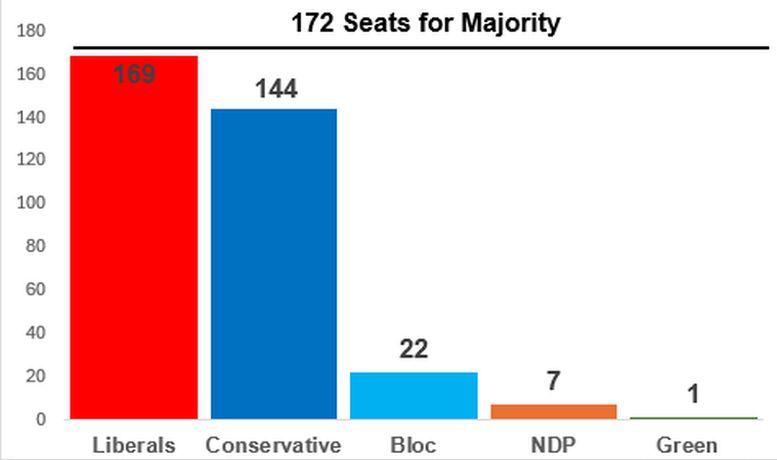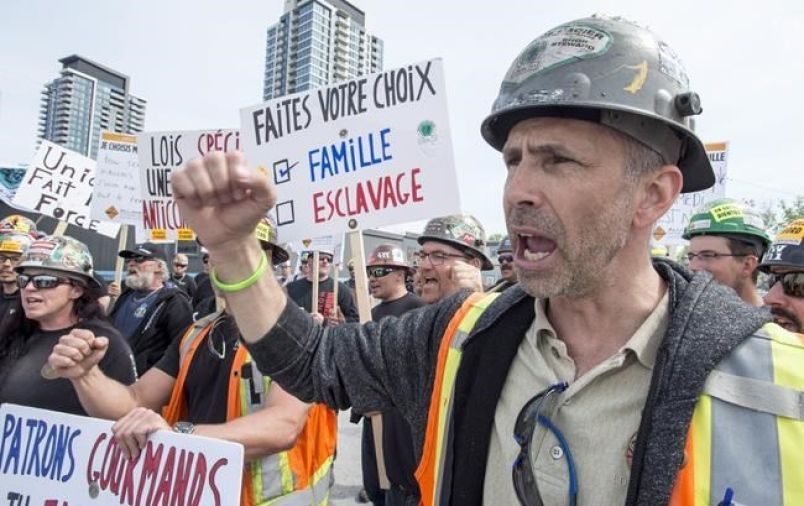In a result that would have been unthinkable just four months ago, the Liberal Party of Canada has won its fourth consecutive election, securing another minority government. Polling showed that the Conservative leader, Pierre Poilievre, was poised to win a historic victory. Instead, he lost the seat he has held since 2004. This demonstrates the volatility of Canadian politics.
The Liberal Party made significant gains in Québec: winning 44 seats, up from 35 in 2021, picking up seats previously held by the Bloc Québécois. They won new seats in the major urban centres, including Toronto, Vancouver, and Montréal, and made small but significant inroads in Alberta and Saskatchewan, regions that are otherwise Conservative strongholds. Overall, the Liberals won 43.7 percent of the popular vote, the highest of any party in a federal election since 1980.
While the Liberals won the most seats, both Liberals and Conservatives improved their popular vote share. Outside of Québec, all other competing parties collapsed. For the first time in nearly 100 years, the Canadian election was a two-party race. The People’s Party, an upstart rival to the Conservative Party launched by Maxime Bernier after he lost the leadership race to Andrew Scheer in 2017, went from 4.9 percent of the vote in 2021 to only 0.7 percent in 2025. While Green Party co-leader Elizabeth May kept her seat in Saanich-Gulf Islands, the Greens dropped from 2.3 percent to 1.2 percent of the popular vote, their worst performance since 2000. Most disastrous was the fall of the New Democratic Party (NDP), dropping from 17.8 percent to 6.3 percent, its worst result ever, and losing its official party status.
The new House of Commons will look distinctly different from the old. Of the four major party leaders at the end of 2024, Justin Trudeau resigned and did not run again, and both NDP leader Jagmeet Singh and Pierre Poilievre lost their own seats (although it seems likely Poilievre will attempt to win a seat in a byelection as soon as he can). However, it is up to the Prime Minister to call a byelection, and it could be months before one is held. Until then, the Conservatives will need to select a leader of the Official Opposition. While the party that forms the government will have the same name as before, that belies the dramatic upheavals that have taken place.
Conservatives down but not out
Pierre Poilievre’s Conservatives appeared to be cruising to an easy victory as late as early January, but were suddenly and decisively outmaneuvered. The Liberals took advantage of the national crisis created by Trump’s trade war and annexation threats by ditching the unpopular Justin Trudeau and replacing him with the former banker and self-identified “elitist” Mark Carney. Carney was able to portray himself as the “responsible adult in the room,” and pulling the Liberal Party to the right politically. While Poilievre losing his own seat in the Ottawa area is a major embarrassment, and has some in the Conservative establishment questioning if he should stay on as leader, it has wider implications for the next few months as the Conservatives work to mount an effective parliamentary opposition to the new minority government. But at least so far, Poilievre is saying he will stay on as leader, and not without good reason. Digging into the details of the election results, it’s certainly not all bad for the Conservatives. They performed well in Atlantic Canada and won several new seats in Ontario including the “905” and Niagara region (more on the implications of this below). The Conservative party won 41.3 percent of the vote, the highest percentage of votes ever in the party’s 22-year history since Stephen Harper reunited the Canadian right in 2003.
NDP humiliation
The NDP kept only 7 of its previous 25 seats, winning just 6.3 percent of the popular vote, its worst ever performance in a federal election. Jagmeet Singh lost his seat in Burnaby Central and resigned as the leader of the party. The NDP’s remaining seats are in the cores of major cities, with its only non-urban seats being Nunavut and Courtenay-Alberni on Vancouver Island.
To put this in perspective, the NDP, and its predecessor the Cooperative Commonwealth Federation (CCF), first ran candidates in a federal election in 1935 and won 8.9 percent of the vote. In the subsequent 26 federal elections, the NDP/CCF won 10 percent or more of the popular vote, with only two exceptions in 1993 and 2000. It’s unusual in a Canadian federal election that two parties (the Liberals and the Conservatives) both won more than 40 percent of the popular vote; in fact, this has never happened in any federal election since the formation of the CCF/NDP.
Unfortunately, the NDP is only reaping what it has sown. Socialist Alternative warned back in 2022 that, by supporting the governing Liberals, the NDP was setting themselves up for inevitable electoral disaster. For over two years, the NDP had a formal agreement with the Liberals to support them in exchange for key legislation. While this did result in a flawed dental program and an extremely limited pharmacare plan for some people, we argued better results could have been achieved without the NDP agreeing to prop up the government.
In the face of a perceived national crisis, for Canadians who wanted to keep Poilievre out of government and deal with the threat of Donald Trump, the question became: “If the NDP basically supports the Liberal Party anyways, why bother voting for them when we can vote for the real thing?” Many people in Canada had real fears of a Poilievre-led government — Poilievre was seen by many as most Trump-like. For that reason, strategic voting was a big factor in this election and that had significant impact on votes for the NDP. Ironically, strategic voting resulted in many Liberals winning previous NDP seats or splitting the vote, which resulted in Conservative wins.
It’s a bellwether that the NDP lost Hamilton Centre, historically one of the most secure seats for the federal NDP. The fact that the Conservative Party was able to make gains in the Niagara region, the manufacturing heartland of Ontario, is significant. Working-class voters in these areas, including some private-sector unions, came out to support Poilievre’s Conservatives. These voters could once be relied on to vote for the NDP. But today, working-class people are looking for radical change from a status quo that isn’t working, and the NDP did not portray itself as a party of radical change, while Poilievre’s Conservatives did. The course that the NDP leadership and its supporters in the leadership of the labour movement has taken has proven to be disastrous for representing the interests of workers in electoral politics.
There may be further irony in the prospect of the NDP, even without official party status, to be in a position where it holds the balance of power in this minority-led parliament. If it does exercise this power, it should learn the lessons from the past few years and not lock itself into a situation where it is propping up a minority government. A further period of close support for the Liberals would probably destroy the NDP. Instead, it could exercise its influence by making radical demands to improve the lives of the working class. In 1972, the NDP did just that: it was successful in winning a national health care program when it held the balance of power in a minority Liberal government.
Québec: the Bloc lost ground
The Liberal Party outperformed expectations in Québec. Many thought that Carney, a staunch federalist, would not do well with voters protective of national autonomy for Québec. Carney opposed both the Québec government’s use of the notwithstanding clause to pass the Bill 96 language law, and its request for more say over federal judicial appointments. But in the context of annexation threats from Trump, the prevailing mood of Québec voters was that Québec autonomy is better secured within the Canadian confederation rather than as part of a “51st state,” where there would be no language rights.
The leader of the Bloc Québécois (BQ), Yves-François Blanchet, pivoted from the confrontational approach of his provincial counterparts in the Parti Québécois and the ruling Coalition Avenir Québec and ran on being a strong partner to Carney in the “Team Canada” approach to dealing with Donald Trump. This likely saved the BQ a few seats that it would have otherwise lost to the Liberals. While the BQ went from 35 seats to just 22, their influence in Parliament may grow. They hope to hold the balance of power in a Liberal minority government and as such, could have outsized influence at the “Team Canada” table. However, the Liberals are more likely to lean on the NDP, after all they have history and relying on the Bloc risks charges of support for separatism.
What comes next?
While Carney’s Liberals are currently riding high on their election win, the future is very much uncertain. The Liberal Party’s fortunes rose from the dead just 4 months ago because of the external threat of Donald Trump. The length of the “honeymoon” that Carney’s government will enjoy will depend on how tariff negotiations go in the coming weeks, and the Liberal support could evaporate just as quickly as it rose. No matter what happens in the trade war, the Carney government will not improve the lives of working-class people. Just like Donald Trump was able to make a comeback in 2024 after losing to Biden in 2020, it’s only a matter of time before a more extreme right-wing government comes to power in Canada unless a left-wing socialist alternative can be built to capture the mood for radical change.
Poilievre has said he will stay on as leader of the Conservative Party and he remains popular with his base. These last 4 months revealed serious fractures within the Canadian Conservative movement. Poilievre rose to power in the Conservative Party by riding the rising wave of right-populism that was unleashed by the so-called “Freedom Convoy” of 2022. This right-populist base is centred in the Western provinces of Alberta and Saskatchewan, and one of its most outspoken champions is Alberta Premier Danielle Smith. Smith shared a platform with Ben Shapiro, who wants Canada as a US colony, but without democratic rights. She deflects calls for annexation from Trump by arguing it is unnecessary because Poilievre is “in sync” with Trump. On the other hand, the more established wing of the Conservative movement is championed by Premier Doug Ford of Ontario. Ford conspicuously refused to support Poilievre during the election, focusing instead on being an enthusiastic partner in the Liberal government’s “Team Canada,” sporting a cap with the slogan “Canada is not for sale.”
Preston Manning, elder statement of the western wing of the Conservative movement, warned of the re-emergence of “western alienation” into Canadian politics. While expressions of “western alienation” is often wrapped up in the language of secession, aping the rhetoric of Québec separatism, the idea of the west actually seceding from confederation is a fringe view. But the idea that “the west” is being taken advantage of and not having its due influence in federal politics is an idea that has gained a base of support before, and it could find resonance again in the new right-populist mood in Canada. Leaders like Smith are playing into this mood, while others like Doug Ford and former Alberta Premier Jason Kenny are resisting it in favour of “national unity” — the national unity of the Canadian bosses and big business.
The coming months will be a reckoning for the Canadian working class and labour movement. The devastating loss of the NDP should raise serious questions in the minds of anyone who believes in independent working-class politics, opposed to both the Liberal and Conservative wings of pro-capitalist politics.
It’s significant that a sizable number of young Canadians are supporting the Conservatives. In a Nanos poll from April 24 to 26, of those polled between the ages of 18-34, 38.8 percent supported the Conservatives, 36.3 percent supported the Liberals, and only 13.8 percent supported the NDP. In a mock election organized by Student Vote Canada, with 900,000 students participating in elementary through secondary school, the Conservatives won the election with 165 seats. This is another sign that the NDP strategy has been a disaster for the Canadian working class. A Fraser Institute poll in 2023 showed that 50 percent of Canadians aged 18-24 thought that Canada would be better off by switching to a socialist system, with 13 percent supporting “communism.” Young people are desperate for radical change. If a bold socialist program had been put forward by an established political organization, it would have achieved mass appeal. Instead, with no bold program for change coming from the mainstream left, young voters turn to the right populists who are seen as preferable to the other options of “status quo” and “status quo-light.”
It will not be sufficient for the NDP to merely replace Jagmeet Singh with a new fresh face that could poll well against Mark Carney. The whole nature of the political organization of the working class in Canada must be re-examined. The socialist victory in the Vancouver byelection can provide a positive example of how a bold left and pro-worker program can win mass support. Socialist Alternative Canada has consistently called for a political party for the working class that is based in grassroots democracy, with an active membership that campaigns year round in working-class communities, and that would be an organ of class struggle rather than merely a ballot-line in election years. The building of this organization will require a mass movement, a coalition of political trends, and the active support and leadership from unions. Socialist Alternative would be an enthusiastic participant in the effort to build such an organization and would argue within it for a revolutionary socialist program in the interests of the international working class.




